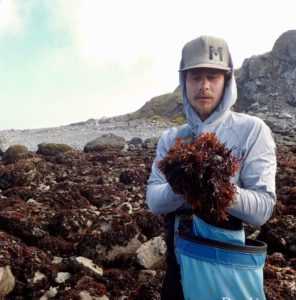NUCLEAR RADIATION HAZARDS for THYROID HEALTH and FUNCTION
In an unintended nuclear war, our thyroid glands and hormones are being continually assaulted by Iodine 131. Iodine 131 is a radioisotope artificially produced from the fission of uranium. Iodine has no natural isotopes. Uranium nuclear reactors continually release Iodine 131 into the atmosphere (3). This is legally permitted by the various nuclear industry regulators worldwide. These ongoing obligatory Iodine 131 releases are officially considered safe and harmless (3). There is no apparent effort to stop these releases. I believe that for 60 years, Iodine 131 releases from nuclear explosions, accidents, and nuclear facilities have been a significant factor in the worldwide increases in thyroid pathology.
SOME HISTORY
Iodine is a very special element. It is both rare and stable, occurring as about 65 parts per billion in the Earth’s crust (1/15,000,000) and about 50-60 parts per billion in seawater (2). Since it has no natural isotopes, it stays reliably the same.
About a half billion years ago, early chordates (the vertebrates and animals with a notochord) decided to use Iodine 127 for their respective thyroid hormones. This decision to use stable Iodine 127 as the definitive element in regulatory hormones is probably a significant factor in Chordata survival and success.
Chordates developed in the oceans where Iodine 127 was always available. Once chordates moved onto land, their iodine requirement became problematical. Land animals must derive their iodine from food and water. Fresh water often has less iodine than seawater. Unlike seaweeds, land plants seem to have no requirement for iodine and thus accumulate very little iodine.
Over time, most land animals developed efficient Iodine 127 extraction and storage mechanisms, becoming innately iodine-conservative with iodine reserves stored in thyroid glands and secondarily as circulating iodinated hormones bound to blood globulins. The absolute stability of Iodine 127 favored reliable long term storage.
Prior to the 1940’s, there was no biologically available Iodine 131. This means that prior to the development of nuclear devices and facilities, animals had no prior experience with unstable Iodine 131 and probably no special protective mechanisms.
Are animals at risk for Iodine 131 uptake and subsequent radiation damage? Yes and no. Amazingly, animals can detect the atomic weight differences between the lighter stable Iodine 127 and the heavier unstable Iodine131. But, this is apparently the only detectable difference between the two iodine forms. Because of their innate iodine conservation mechanisms, iodine-dependent animals will readily take up radioactive, heavier Iodine 131 if they are deficient in Iodine 127. The Iodine 131 is placed in molecules, cells and tissues where iodine is needed, just as if it were Iodine127. The safety factor is: ANIMALS WITH COMPLETE BODY COMPLEMENT OF IODINE127 TEND TO NOT TAKE IN RADIOACTIVE IODINE131.
Therapeutically, the obvious preventive action for humans is to insure a complete body load of Iodine127 at all times by eating iodine-rich foods, using iodized salt, or taking a supplement with the RDA of iodine (circa 150 micrograms). The Iodine 127 in all foods is stable forever even if the foods are not. I recommend against keeping iodine solutions, iodine salts (usually sodium or potassium iodide) and iodine tablets in homes with young children to prevent poisonings.
In developed countries, iodized salt is probably the easiest and safest way to obtain and store iodine at home if kept in completely dry and airtight containers.
The best food sources for dietary Iodine127 are seaweeds.
THE CHINESE SOLUTION TO IODINE DEFICIENCY
After thousands of years and millions of iodine-deficiency-induced mental and physical retardation cases and entire villages of subclinical cretins, China decided that seaweeds would be the most reliable and cheapest sources of dietary iodine. They decided to try and develop varieties of the large brown seaweed Laminaria for extensive aquaculture. Laminaria spp have large amounts of iodine, from ca 1000 to 8000ppm, dry weight. Most of these Laminaria spp grow only in cold northern waters. The warm waters offshore from China are too warm for wild Laminaria to survive.
The Chinese raised Laminaria in refrigerated pools where they subjected the plants to various mutagens. Eventually they produced a warm-water tolerant Laminaria variety and began massive seaweed aquaculture in the Yellow Sea. Whole communities are dedicated to producing kelp “seed”, maintaining the farms, and to harvesting and processing the plants. As a result, China is able to meet the iodine requirements of 25% of the Earth’s human population from farmed kelp, with an annual farm production of about 700,00 dry metric tons (Druehl).
REAL HAZARDS FROM IODINE131 EXPOSURE
Everyone and everything everywhere is dusted continually with small amounts of Iodine131. This unstable isotope has an 8-day half-life. It decays to Xenon54 with the concurrent release of a high-energy Beta particle and high energy gamma radiation with each atomic decay. Beta particles and gamma radiation produce tissue damage and cell death. The radioactive decay features of Iodine 131 are effectively used by the thyroid industry to very efficiently cook errant thyroid glands. The action is euphemistically called “ablation”, from the Latin, “to carry away, remove”. (Is this what was meant in first year Latin by “ablative absolute”?)
Patients undergoing Iodine 131 thyroidectomy are often given a pleasant handout describing the complete safety and minimal discomfort from the radiation ablation of their thyroid gland. On the reverse side of the same page are warnings against getting too close to anyone you care about for at least 6 weeks: no nursing, no intimacy, no hugging, no sharing of toothbrushes (?) or towels, etc. It is curious that the procedure is safe for the patient but potentially deadly for anyone (including pets) within 10 feet. In truth, there may be no safe low exposure to either Beta particles or gamma radiation; we do not really know.
So, instead of complete frying of our thyroid glands, we are experiencing continual low level radiation damage wherever Iodine 131 decays in our bodies. I believe the negative affects are slowly accumulative and health compromising.
THE IGNORED IODINE131 HAZARD
Xenon is the elemental product of Iodine131 decay. I found no mention of it in the thyroid literature. A noble gas and presumably completely bio-inert, Xenon is ignored.
Although endocrinologists may ignore the Xenon produced from Iodine131 decay, biological systems cannot. All biological molecules tend to have prior commitments; their presence is purposeful. This includes unfortunate molecules with incorporated Iodine131 atoms. When a thyroid hormone molecule experiences radioactive decay of one of its iodine atoms, that atom disappears with an inert gas suddenly left in its place; any functional event involving the thyroid hormone molecule with Iodine131 decay will experience at least structural disruption and possibly destruction. All of the intended subsequent hormone-dependent functions will be terminated prematurely. And the Xenon? It exists, it has mass and must be spatially accommodated where as a gas it will presumably diffuse away possibly disrupting molecular activities. Animals do not take up Xenon and have no ready mechanisms for its safe processing.
More to the point, prior to 1944, no iodine in biological reactions just “disappeared”. There are probably no adaptive mechanisms to recover easily from disappearing iodine. Animals have relied on the stability of natural iodine for 500,000,000 years.
I believe that disappearing iodine has a long term insidious health negative affect on humans and is a major factor in chronic thyroid illnesses.
How can we determine our individual probable exposure to Iodine 131?
In the United States prior to 9-ll, Iodine emissions data from nuclear facilities were usually publicly available. Since 9-11 security concerns may impede access. Allowable Iodine 131 releases for each nuclear facility are calculated on a presumed average daily release amount. Apparently Iodine 131 releases are at irregular intervals and in bursts rather than steady amounts. This means a lot of little clouds of radioactive iodine circling the earth released from the hundreds of worldwide nuclear facilities. The iodine falls out onto plants where it can be consumed by herbivores including dairy animals. Since it has a half-life of 8 days, it can persist as a thyroid hazard for up to 8 weeks in food, air, and water. If one is worried about Iodine 131 in foods, keep them for 60 days (freeze fresh seafoods) until the biogenic hazards from Iodine 131 decay are nearly zero.
CHERNOBYL, APRIL 26, 1986
On this date at least one nuclear reactor exploded, sending millions of microcuries of Iodine131 into our shared atmosphere (1). Since then many studies on the subsequent millions of cases of thyroid disease resulting from mostly exposure to Iodine131 have been published and continue. A recent article in the Seattle PI (4) commented on the sharp increases in thyroid cancer amongst children in the years since Chernobyl; from rare to very common; thyroid cancer is now the most common cancer of children. I doubt this is a coincidence. Cancer is also the leading cause of death in children in the USA. 100 years ago, childhood cancers were rare.
One very bright spot in the ongoing Chernobyl tragedy is the Polish experience. Within hours of the initial blasts, the Polish government was alerted and it immediately ordered iodine tablets, solutions, seaweeds, anything available with Iodine127 in sufficient amounts to as quickly as possible give as many Polish citizens as possible a full body complement of Iodine127 so that they would be less susceptible to the hazards of Iodine131 decay. The experiment apparently worked and Polish citizens enjoy an otherwise unpredictably low incidence of Chernobyl-sourced thyroid disease.
Other governments quibbled about what had happened and who was responsible etc. rather than alerting and protecting their respective citizens. The next nuclear disaster is always imminent due to human error, design failure, material decay etc. Protect yourselves and keep your body iodine needs satisfied.
To save the thyroid health of all the world’s humans and animals, I urge dismantling of all nuclear facilities that currently generate Iodine 131.
X-RAY HAZARDS for the THYROID GLAND
The worst obvious X-Ray hazards to the thyroid gland may be history (see Greenspan and Strewler, op cit). Responding to desperate patients and without a knowledge of the serious long term health consequences of large doses of X-Rays, ionizing radiation, X-Rays were beamed directly onto the scalp to quell scalp ringworm (Tinea capitis), onto the face for chronic acne, onto the throat for chronic tonsillitis and the chest for asthma, bronchitis, and suspected enlarged thymus; the latter usually in neonates and toddlers.
Many of these patients went on to develop goiters, nodules, hypothyroidism, or thyroid cancers with a latent period of 10-50 years and peak tumor incidence 20-30 years after exposure (Greenspan and Strewler). Those thyropathic X-Ray treatments were mostly discontinued in the 1970’s.
The relatively exposed human thyroid gland has no bone barrier to protect it against either gross physical impact trauma or incidental X-Radiation. There is increasing evidence that the unshielded thyroid gland is susceptible to long term developmental damage and disease subsequent to one exposure to diagnostic dental or chest X-Rays and perhaps CAT scans. Some researchers and physicians are strongly recommending thyroprotective neck collars for all patients receiving any head or chest X-Rays, especially pregnant women. Some evidence suggests that diagnostic-sourced maternal thyroid damage produces antithyroid antibodies which may attack the fetal thyroid gland and cause fetal brain damage.
I believe that incidental diagnostic X-Rays may induce thyroid disease after a relatively long latent time and may be an important negative synergistic factor in the increasing incidence of thyroid diseases.
ANTITHYROID ANTIBODIES
Physical trauma and ionizing radiation can rupture thyroid follicles and force thyroid peroxidase (TPO) and thyroglobulin protein (TG) into the bloodstream. Usually antibodies are produced immediately to capture the escaped TPO and TG. These antibodies will persist, particularly TPOab. These same antibodies are often present in thyroid disease. Many people in the general population with no obvious thyroid pathology will test positive for thyroid antibodies, particularly TGab which is regularly and normally released into the bloodstream in small amounts.
TPO is not generally released into the bloodstream and TPOab may indicate previous thyroid trauma or disease. Some researchers think that antithyroid antibodies might become useful predictors of impending or eventual thyroid disease.
PRODUCTION of THYROID HORMONES
Thyroid hormones are not produced in thyroid cells. They are produced in special leak-proof chambers called “follicles” created by tightly grouped follicular cells. Within the follicles, thyroid peroxidase (TPO) is the remarkable enzyme, which assembles T4 and T3 from iodinated tyrosine molecules within the thyroglobulin (TG). Whether this process is too complex or too dangerous for the intracellular environment is unclear. The body’s hypervigilant immune response against TPO and TG indicates that extrathyroidal production of thyroid hormones is to be completely avoided if possible. Unregulated thyroid hormone production could be very disruptive or fatal.
IN PRACTICE
If thyroid disease is suspected and antithyroid antibodies TPOab and TGab are present, do not assume that it is either Hashimoto’s thyroiditis or Graves’ disease. Inquire about ANY previous ionizing radiation exposure from diagnostic, therapeutic, or occupational sources, at any time. Particularly ask about grouped exposures associated with dental work, TB testing or tracking pneumonia or emphysema with chest X-Rays. Ask about a history of living downwind in nuclear power plant stack gas dispersal zones. Relatively high levels of antithyroid antibodies may indicate traumatic thyroid history rather than current thyroid disease. In juvenile thyroid disease, inquire about maternal X-Ray exposure during pregnancy.
The importance of determining ionizing radiation exposure history is to discover possible and probable exposures that may have damaged the thyroid gland enough to cause thyroid pathology, which is irreversibly structural and unlikely to be resolved with natural and botanical treatments.
Pay especial attention to patients with a solitary cold nodule greater than 1cm diameter and a history of therapeutic radiation to the head, neck, or chest; their thyroid cancer rate exceeds 50%, as opposed to about 5% for most cold nodule patients.
References
1. Aoyama, M. etal.1986. High-level radioactive nucleides in Japan in May 1986. Nature 321:819-820
2. Druehl, L. 1995. Pacific Seaweeds
3. Merck Index 1968. 8th edition
4. Shannon, Sara. 1993. Diet for the Atomic Age
5. Paulson, T. 2.Sept.2004. Seattle P-I “Seattle study of Chernobyl finds thyroid cancer link”. Quotes Dr. Scott Davis, Hutchinson Cancer Research Center




